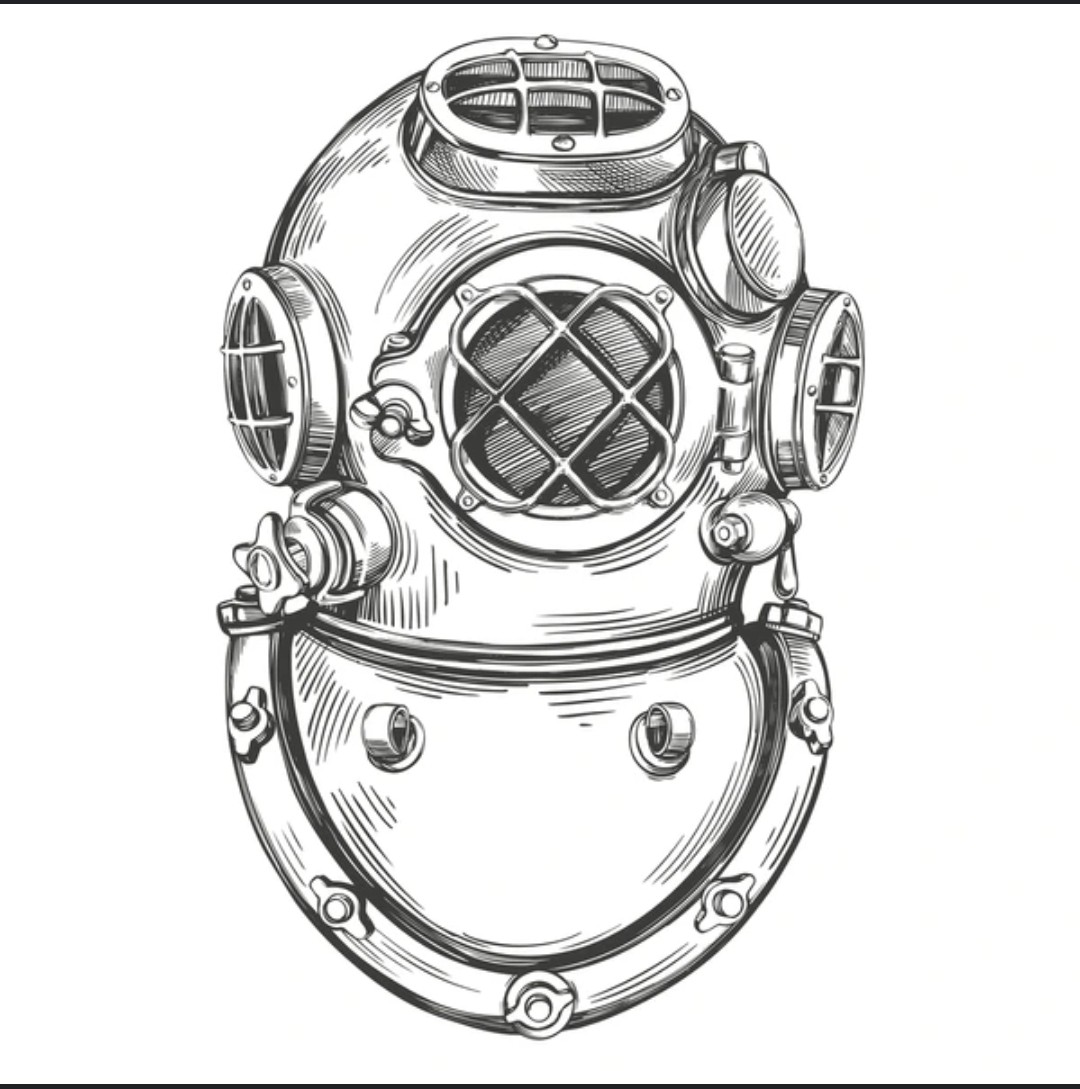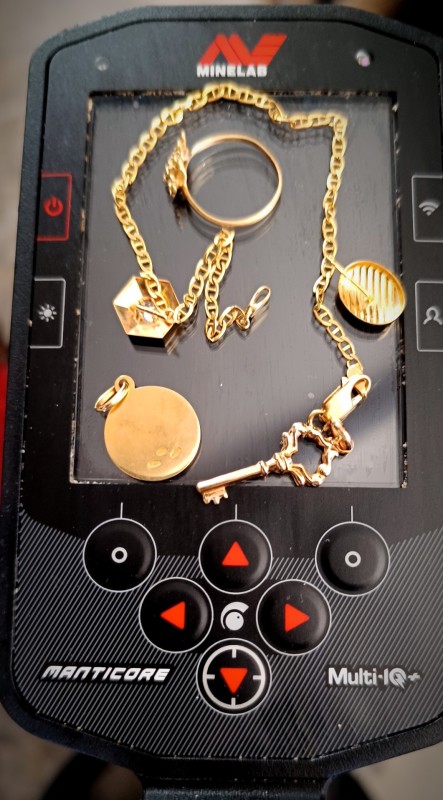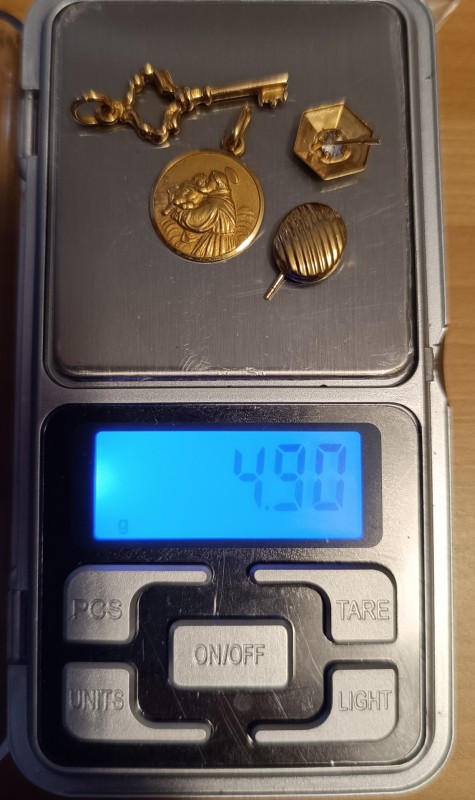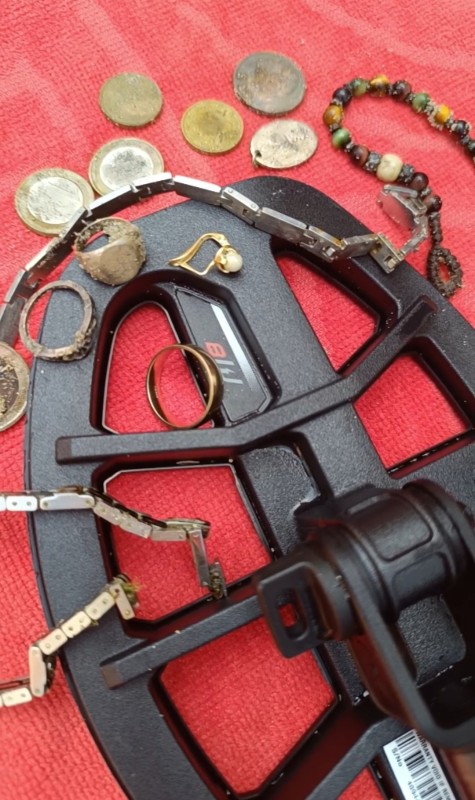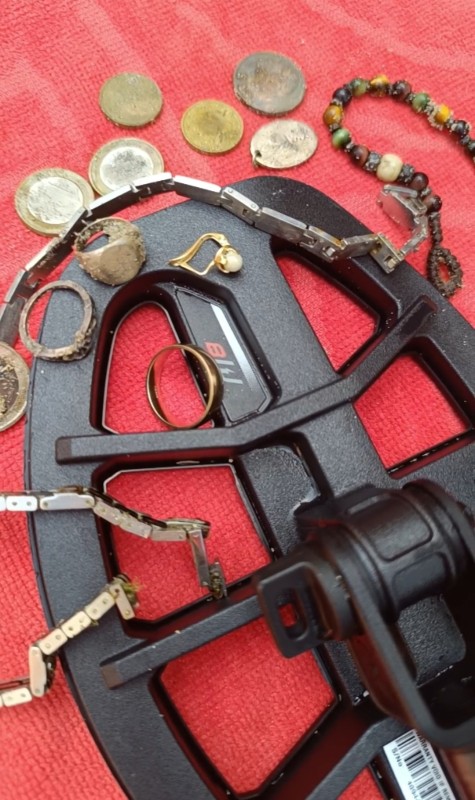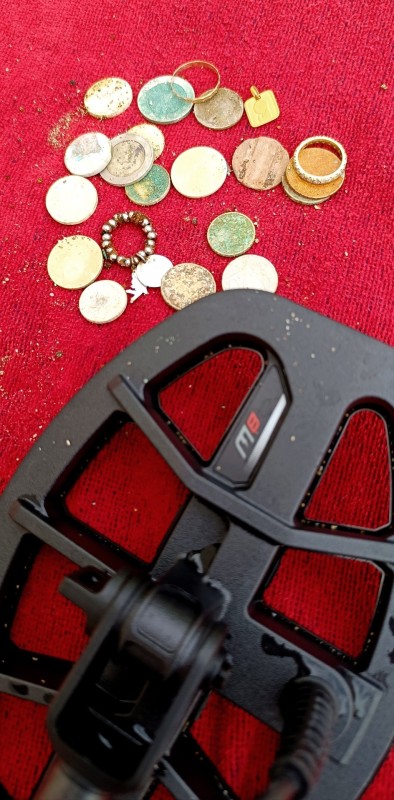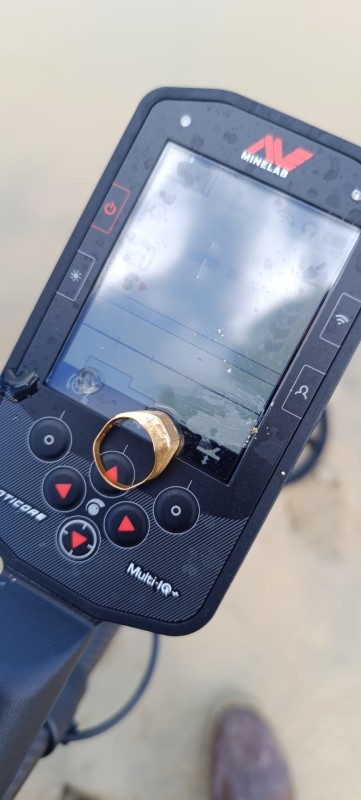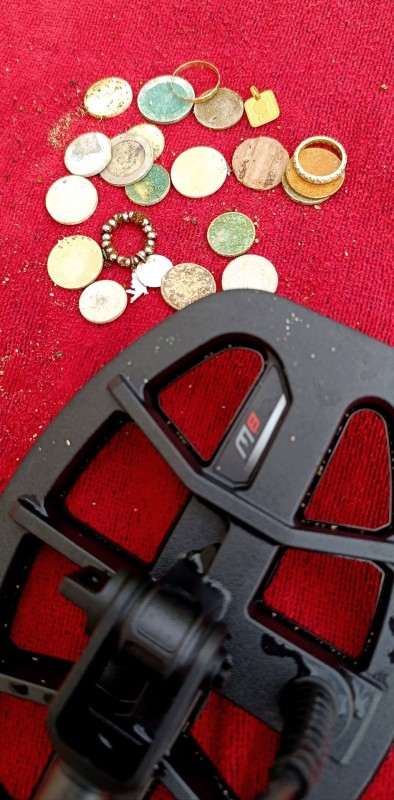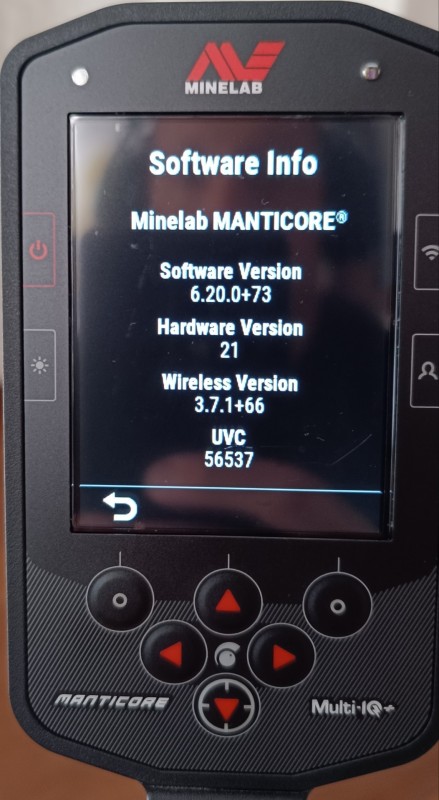-
Posts
827 -
Joined
-
Last visited
Content Type
Forums
Detector Prospector Home
Detector Database
Downloads
Everything posted by Skull diver
-
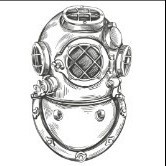
Does The Manticore Need Another Update
Skull diver replied to Chesroy's topic in Minelab Manticore Forum
Exactly....I'd never touch anything on the machine and I would keep it like it is now. Do you know what? I just need a clock 🤣 -
I hope I am not confusing you more, but I suppose it is worth considering another course of action. I don't know how high your threshold is for a ferrous tone that repeats often, but with smaller ferrous limits under and above the 2D line first and an audio ferrous tone on pitch1, surely a "dirty" signal is much better distinguished from a non-ferrous, clear one. Also about tones, I'm talking about using depth audio themes instead of single bins. All metal and red numbers do a great job without dumbing down the instrument and still the screen indicates potential iron. Also, the volume of iron equal to nonferrous enhances a signal worth digging much more. By raising the sensitivity beyond 23 points, I have noticed that instead it is better to increase the separation rate to 6 in some cases. Be prepared to listen to a very frequent ferrous grunt, but then tell me what happens in the same context....
-
Great question...I just know that the Deus it is however a good machine and produced as well, but not at this rate. I complained about the low conductors ID's shown way higher in the numbers and Xp gave me the negative answer about a future mod. I feel still a rookie with this machine and aniway the damn light stuff pops out in places where an army of my competitors had been plus me. It is hard to remain cold in front of a such fine gold sensitivity...I measured pieces under the gram with a strong and clear signal like a common target or a coin. No matter the coil and the higher or lower sensitivity level. With lower levels you get silence and clear signals. With higher levels you get some more noise but again an unmistakable warning when something is under the coil. I use the beach LC program which is not the proper one for diving and doing well the same. No tones but a pitched sound in the depth mode with initial and final pitch to modulate and get an idea of target distance to dig. The prospecting audio theme remains to use above the surface with a calmer session and not rushing against the leaving slack. I just can say that is a more forgiving machine, cause with wrong settings I had the impression to make blind the D2 to gold. And trust me if I say that I struggled one year to make the killer program before to sell it...
- 5 replies
-
- 4
-

-
- jewelry detecting
- jewelry found
-
(and 1 more)
Tagged with:
-
Exaggeratedly tired but nevertheless satisfied after last week with Manticore. These pieces popped up in a couple of spots where I have been previously and even with the right conditions they still seemed to be somewhere waiting to be flushed out. I am beginning to get a feel for the capabilities of this instrument.... Have a great weekend to all of you!
- 5 replies
-
- 11
-

-

-
- jewelry detecting
- jewelry found
-
(and 1 more)
Tagged with:
-

Higher Sensitivity Causing Iron Signals
Skull diver replied to stateguy's topic in Minelab Manticore Forum
Solved raising a little the target separation level. Hand in hand with higher sensitivity levels. I just use beach low conductors and with M8 or M11 usually at 22 on the wetsand and 20 underwater I'm fine... Keep in mind that Dankoski's settings are the reason of a "wanted iron grunt"...Not only the iron but even the falsing takes place with the iron pitch you decide to set. Keep it at 1 and feel confident in a better response when a good target appears. My two cents... -
I had the same experience yesterday morning while on the bottom of a spot that I hate given the difficulty in getting past a barrier of rocks. Exactly 4 small pieces in the range of half a gram to two and a half grams. In addition to a really thin 3.15 gram bracelet found in another spot where nothing sounded. It seems the M8 it is the tool to re-check supposed hunted out spots for remaining stuff💣
-
After the second week, I'm still a newbie with this machine, but apparently, applying the basic good principles the results are yet on another level. There's a place where I hate to dive, due to terrible shaped rocks that can destroy elbows and knees if a minimum wave push me against it when I'm in between and searching. The fact is that those traps helps to keep the stuff really good. This stretch of a private beach it is made of solid rocks more than moving boulders and with some erosion affecting the spot, it means really few brave people able to swim and as a direct consequence, nothing to search after the summer... But, I tried again today after being there months ago with every detector I have in my shed and surprise surprise 🫢... I named trust building this post cause the two gold pieces I pulled up downthere are a clear evidence of a better time management during the session. This morning I tuned the Manticore to be scary quiet and just stopped the few times a pure "non iron" signal it was requiring attention. The number of people that searched in this spot since always, left so few targets to listen that most of Us never even talk about or try to go again...It just don't worth the effort... Well, the picture proves different🫢. I'm not overjoying and I recognize the small M8 advantage between tight crevices, but after the 6" and the Ctx... Here's the moment when I can say goodbye to my old trusted sniper rifle.... I never tought this could happen one day...
-
- 1
-

-
- jewelry detecting
- jewelry found
-
(and 1 more)
Tagged with:
-

New Manticore Defective Out Of Box
Skull diver replied to Steve Herschbach's topic in Minelab Manticore Forum
You'll solve the 11" bug hopefully soon, meanwhile try to put the M8 in an hard pounded place and wait for a surprise 🫢... This happened to me again today... I'm speechless -

I Feel Like I Got Screwed. What Say You?
Skull diver replied to khouse's topic in Minelab Manticore Forum
As for me, payed the full price with a slight discount on the M8 cause I've personally taken both at the dealer's new shop. I don't mind the highway and gas price against a subtle bargain but I mind that in Europe it seems we'll not benefit of this price discount. I tell You, I'm maybe one of the few that will buy another Manti tomorrow for the right price...🫢 -

Do You Dig Signals With No ID And No 2d Trace?
Skull diver replied to Dug D's topic in Minelab Manticore Forum
I've seen this behaviour when air testing for the first time some targets. Bad weather outside, being inside home, forced to keep no more than 7 as sensitivity level, in beach LC and prospecting audio mode... No matter the items, an amazing faint treshold wisper was giving a clear chance to listen for a target by a third more of distance before an ID and a proper trace showed up. It happened with a silver 0.37g ring so thin to be hard to believe. With the 8x5" coil this means like almost 12" without ID but clear treshold variation. I repeat, 7 sensitivity on M8 coil and prospecting audio mode. Soon realised that wasn't the ideal setup for me in saltwater...But on the wet and dry sand, keep an ear on those "pre signals".... -
Replying with a little delay cause still testing days ago the basic settings to suit my usual job... As lot of Us can confirm, an higher sensitivity with both the M11 or M8 can lead to an erratic reading after 20 points. I wrote about this fact when noticed in the very first air test a big footprint around all the coil's sides. To have a clear idea of how much the field expands around the coil, just move a coin or a pulltab near, under and above. So nothing wrong with the use of a third of total sensitivity in some cases, just stop at the first acceptable falsing noise and return a couple of points down to obtain the right level. That's it, the beast its doing it's job really good for me. As for separation, the preset of 4 it is a good balance at least for me cause otherwise lower to 3 or 2 the saltwater starts to sound as a background chirp.
-
It was once 🫢. In 2007 Me and my dive buddy were searching for gold and it was appearing almost everywhere. Today We don't even search together the same area as a form of respect, due to the lower concentration of finds. What I post here is like 10% of what I've seen in 2 decades💀
- 3 replies
-
- jewelry found
- jewelry detecting
-
(and 1 more)
Tagged with:
-
Last monday I finally started the test phase with the Manticore and the M8 underwater. After a minimum of settings adaptation, I recovered three small and light pieces for a total amount of almost 6 grams in total. Tuesday underwater again and Wednesday wetsand workout, nothing to register...Until today on the wetsand...I was again with the M11 and after the usual coins and an unexpected sinker on the slope, minutes after a solid 17 screaming to dig it. It was a 4.45g 18k piece. What else can I say...Jeez...If there's something left, this is the most similar tool to a vacuum cleaner 😅
- 3 replies
-
- 1
-

-
- jewelry found
- jewelry detecting
-
(and 1 more)
Tagged with:
-
I've been tempted to follow some uncovered clay/rocks patches further from shore, but as for now, I think there's a lot to check again in the shallows. The program I used I'd say "accidentally" it has some real potential to pull out remaining thin stuff with my big satisfaction...The M8 puts steroids on this machine.
- 5 replies
-
- gold found
- jewelry detecting
-
(and 1 more)
Tagged with:
-
As I told last week, I was preparing the Manti for today's session on the seabed. In a few words, "damn it works"... Even if I abused the machine using underwater the beach LC program, I however managed to take with me three pieces. The second attempt will be with surf and seawater, which I think it is the proper way to use it when diving. Not bad for the day one💣
- 5 replies
-
- gold found
- jewelry detecting
-
(and 1 more)
Tagged with:
-
Nooo my friend 😂... Absolutely nothing personal for those words, but just telling the hard truth that hit Us all together when looking for gold.... The amount of trash is always higher than cherries and We can do nothing against... To me, it happens continuously to dig pulltabs, just taking a deep breath and mentally saying myself "wrong line, move on"....
-
The air test I've done this morning was with Beach LC and prospecting audio adding some threshold cause it reminds me a lot the Tdi behaviour. Anyway considered the really aggressive reaction to the thinnest of small silver ring (0.37g), will be a challege to obtain the same miracle submerged... Depth audio will do for sure better against moving saltwater.... Honestly, as for now I'm pleasantly surprised even cause I managed to lower separation up to 2...The air however is nothing...
-
As a brand new user, I recently searched and learned the most before to have in my hands the "beast". So this subject on the Manticore caught my attention reading somewhere on the web that using way less sensitivity than the possible amount can give better results. With the premise that I own a Ctx too, in my mind I had a rough idea of what to expect in terms of "reaction" by the machine. Really happy to put the M8 under test for an hour, I've immediately understood the meaning of "less is more". Apparently, I'd say, I perceive the Manti's behaviour like the Ctx, but with a third of sensitivity level🤔. I'm not complaining about anything but I noticed an extreme side sensitivity to targets with both the M8 and M11. A real large footprint sorrounds the coil even at a modest levels of 12 or 16 points and this can be useful like detrimental at the same time by the way...It all depends by the environment you're searching in. Not yet used the machine on the bottom but can't wait for the monday's session to try what the M8 can provide between rocks...
-

Detectors / Coils Question
Skull diver replied to D&P-OR's topic in Metal Detector Advice & Comparisons
I casually discovered with the MUI that the latest software was installed (by the dealer for sure) but not the same thing with the ML105. I've updated them and as for now all works fine🙏 -

Detectors / Coils Question
Skull diver replied to D&P-OR's topic in Metal Detector Advice & Comparisons
-

Easter Bunny Laid A Gogogogolden Egg
Skull diver replied to midalake's topic in Metal Detecting For Jewelry
If it wasn't underwater, I would have to think to be victim of a candid camera 🤣 -

Who Uses A Pinpointer On The Beach?
Skull diver replied to Bill (S. CA)'s topic in Metal Detecting For Jewelry
I recently bought another one (this time cheaper) to use it on the wetsand cause years ago it flooded underwater. You're right about coins but really thin pieces of foil and crappy bits drive me crazy meanwhile trying to locate them out of the hole. I think it helps a lot to don't burn useful time. No matter how small the coil, there are things too small to be seen. -
I was actually wrong saying the camera turned off too soon the last time I had it on my head... So cleaning the card for a new attempt tomorrow, I suddenly found this raw footage. No editing, pure bubbles and fuc#%#g sh## visibility. So this is what I'm usually fighting against. Enjoy the challenge between me and the murky waters.
- 2 replies
-
- gold found
- underwater detectors
-
(and 1 more)
Tagged with:
-
Countdown started 🏴☠️
- 21 replies
-
- jewelry detecting
- underwater detectors
-
(and 1 more)
Tagged with:

